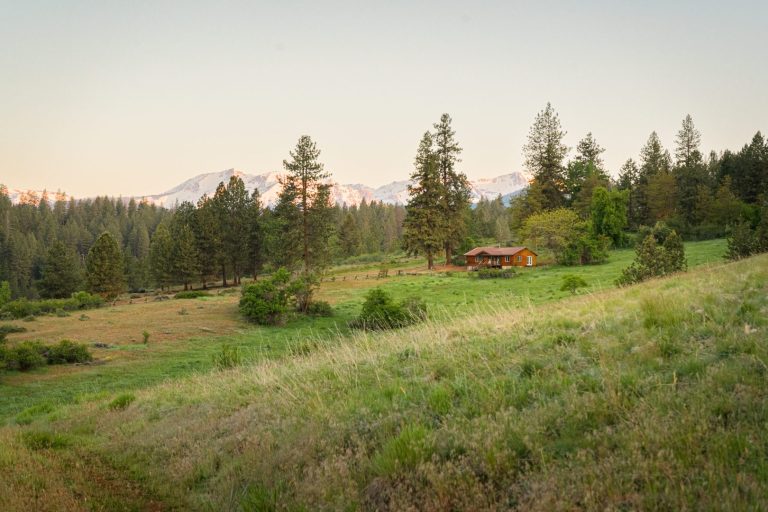The phrase living off the land means many different things to many people.
Its meaning is as varied as the land itself. For some, living off the land may be as simple as eating locally; for some, it means existing off only the supplies available from the land. Many others, like those who maintain farms and ranchers living off the land, is a relationship with the earth under their feet. Living off the land is an exchange, a reward for stewardship of the resource.
Farming with the Land
For many Americans, farming is a struggle for existence, man against nature. Farmers and those close to the produce growers of the country know that while nature and the land can be unpredictable, there is no battle. Farmers maintain the soil quality through fertilization, irrigation, and crop rotation. Many farmers have taken additional steps to limit the abusive practices of the past. Farmers use smarter irrigation systems to keep more water in the aquifer while keeping the ground covered with nitrogen-fixing crops when not being planted for food production. By planting winter crops like kale, Brussel sprouts, and even carrots, farmers can continue to plant and diversify their crops throughout the year even when conditions are less than ideal. By creating buffer zones between fields of shrubs and trees, farmers can make less than ideal growing soils work to their advantage. Firstly, living walls act as a wind buffer to keep topsoil in place during wind and rainstorms. These living walls also caution as ideal nesting areas for songbirds and quail, both types of birds help control the insect population. A reduced insect population creates less need for pesticides and, for anyone who experienced horse flies, a generally more pleasant outdoor experience.
Ranching with the Land
While ranchers may not grow crops, they do indeed grow food, clothes, or any number of other uses we have for animal products. From grazing their herds on well-maintained land to having the best feed available, ranchers live with the land to live off the land. Living off the land also rewards ranchers with higher quality products in the long run. With careful stewardship of the land, such as keeping the herd moving to prevent overgrazing, ranchers grow grass-fed animals that consumers desire. Grass-fed animals are more in line with the quality of meats and dairy products ranched for thousands of years. Not only does ranching with the land preserve the tradition of ranching, but consumers and those who want to embrace the ideals of living off the land want to eat healthier animal products. Grass-fed or finished beef, for example, contains less fat and more vitamin A, E, and Omega-3s than grain-fed beef.
Hunting and Fishing
For property owners that don’t use their land for agriculture living off the land is still a viable option. Property owners can tend to their land in ways that make them ideal habitat for fish and game. This is what living off the land embodies for many people, harvesting wild fish and game to supplement their protein instead of store-purchased meats.

Maintaining a property allows owners to use controlled burns to improve habitat for game birds and even larger animals like deer and elk. Controlled burning of land keeps vegetation that restricts movement to a minimum while increasing the biodiversity of native plants that, in some cases, require fire to germinate. Other forms of stewardship could be planting food plots to guarantee game animals have adequate nutrition throughout the year. Harvesting a few deer a season can provide a family with a freezer full of lean natural protein for many months. Deer and turkeys aren’t the only animals that ranch owners can manage through proper land use.
Farmers and ranchers operating functional agricultural properties can also create additional opportunities for harvesting wild game. Flooded fields and pastures create ideal feeding and resting places for waterfowl on their seasonal migrations. Some of the best wingshooting in the country happens on ranches and fields where hungry ducks, geese, and cranes stop to rest and pick over the remnants of the fall harvest.
Property owners with ponds and rivers have an additional option for living off the land. By maintaining water levels in ponds and lakes, the fish living in the water will reduce the number of mosquito larvae that reach adulthood and, in many cases, can grow to a harvestable size. By sinking additional structures in the water, property owners give fish different places to spawn and grow, increasing fish populations.
Foraging
A popular low impact activity for those who live off the land is to forage. Rather than purposely farmed plants, foraged plants are wild-growing. While modifying the land to increase the growth of wild plants may run counter to foraging at its core, it is a valuable practice for property owners looking to increase their diet without farming. Examples of purposeful stewardship for foraging would be leaving dead standing hardwoods to promote the growth of edible mushrooms known as “chicken of the woods” that only grows on dead hardwood trees like oak and hickory. Damp lowland areas can be managed to promote wild berries like blue and blackberry. Like so many other aspects of responsible land use, keeping more food plants on the landscape is a major boon for both wild game and grazing livestock.

Living off the land is a purposeful pursuit of living closer to nature. Living with the seasons and utilizing the crops and animals that thrive in the environment. By thoughtfully using land and water resources, property owners can reduce their impacts on the resources while maximizing their yield. Living off the land is a common term; it is, however, too broad to illustrate what it truly means to live off the land. A better term for property owners dedicated to protecting their resources is living with the land. Living in harmony and as an active participant in the growth of their property.














